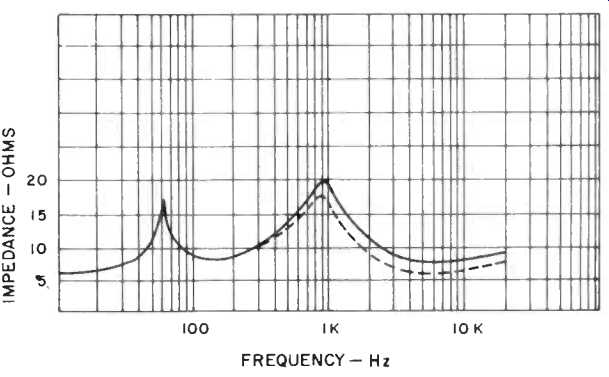
MANUFACTURER'S SPECIFICATIONS
Drivers: 10-in. bass, 3 1/2-in. tweeter.
Crossover Frequency: 1,000 Hz.
Nominal Impedance: 8 ohms.
Maximum Power Handling Capacity: 50 watts rms.
Frequency Response: 45 to 20,000 Hz ±4 dB.
Cabinet: Oiled walnut.
Shipping Weight: 31 lbs.
Dimensions: 23 x 12 x 10 1/2 in. deep.
Price: $79.50; optional fretwork grille kit, $10.00.
The majority of the smaller bookshelf loudspeaker systems are of the infinite baffle (IB) or totally enclosed type, and the few exceptions use a damped reflex arrangement. The Rectilinear XIa is one of the latter type, and it employs a tube vent which is filled with fiberglass to give the necessary acoustic resistance. The theoretical advantages, as compared with the IB system, are a slightly higher sensitivity and an extended bass response. The 10-in. bass speaker in the XIa has a 1 1/2-in. voice coil and its response falls off above 1000 Hz, so a simple 6-dB-per-octave LC network is sufficient to crossover to the HF unit. This is a 3 1/2-in. cone speaker having a closed back. The cone itself is very shallow as a deep cone this size would tend to have poor dispersion. Enclosure resonance is about 63 Hz, and this impedance at this point measured just under 18 ohms, which indicates a fairly low The cabinet is finished in oiled walnut, and the grille cloth is detachable. At the rear is a level control for the treble unit, and we were pleased to note the large input terminals were spaced well apart. No chance of a "short" here.
Measurements

Fig. 1--Response with one-third octave pink noise. Curve A was measured on
axis and B was a 45 degrees off axis.

Fig. 2--Range of the continuous y variable treble control.

Fig. 3--Impedance characteristics.

Fig. 4--Toneburst response at A, 100 Hz B, 500 Hz, and C, 5000 Hz.

Fig. 5--Low frequency distortion and SPL figures.
Figure 1 shows the response with one-third octave pink noise. Curve A was measured on axis and B at 45 degrees off axis. The treble control was set for the most linear response.
Figure 2 shows the large variation possible with this speaker's control-the maximum position having a rise of over 10 dB at 10 kHz. The impedance curve is shown in Fig. 3, and it should be noted that the average is not very much lower than 10 ohms. Thus, the Rectilinear XIa's can be used as extension speakers without any fear of overload damage to the amplifier. Figure 4 gives the low frequency distortion together with some SPL figures at 5 and 10 watt inputs, and the toneburst performance is shown in Fig. 5, where A was taken at 100 Hz, B at 500 Hz, and C at 5 kHz. The system would handle 16 watts continuous power at 40 Hz, 17 watts at 70 Hz, and 84 watts at 100 Hz without distress. Note that this is continuous sine wave power, a rather severe test.
White noise tests showed some coloration in the midrange with the level control advanced above the half-way mark.
Listening Tests
Efficiency of the Rectilinear XIa is above average (the manufacturers recommend a minimum of 10 watts) and a 15-plus-15 watt amplifier will give sufficient power for most rooms. Our tests were made with the Pioneer SX-424 and a Marantz 2010-both of which gave excellent results. With the treble control set for optimum balance, the sound had a slightly forward quality-not that associated with the West Coast but nearer the neutral New England sound. Bass was full and well maintained, and the high efficiency of the treble speaker will allow the systems to be angled inwards slightly to achieve a good stereo image in a large room. All-in-all, a superb sounding system for such a modest price.
-T.A.
CLARIFICATION
In our review of Lafayette's Model LR-4000 4-Channel Receiver (Audio, June '73 pp 56-60), we criticized the wording used by that company to describe their phase-lock circuitry. We felt that their wording implied the use of this circuit in the "front-end" (RF or IF) section of the receiver, which is not the case. Our criticism may have been interpreted by readers to suggest that there is NO phase-lock loop circuit in the receiver. Actually, the very excellent multiplex (stereo FM) decoder section of the LR-4000 DOES employ an advanced Phase-Lock Loop Integrated Circuit, which accounts in part for the excellent separation and low distortion reported in the original review. Our quarrel with Lafayette was basically one of semantics, rather than any implication of misstatements on their part.
-Leonard Feldman
(adapted from Audio magazine, Aug. 1973)
Also see:
Rectilinear III Lowboy Speaker System (Jun. 1972)
Rectilinear Research Corp. loudspeakers (ad, Oct. 1973)
Microstatic Full-Range Loudspeaker (Jun. 1973)
Rogersound RSL 28 Loudspeaker System (Jun. 1973)
Dynaco A-35 Loudspeaker System (Jun. 1973)
Dynaco A-25XL Loudspeaker (Equip. Profile, Nov. 1976)
= = = =